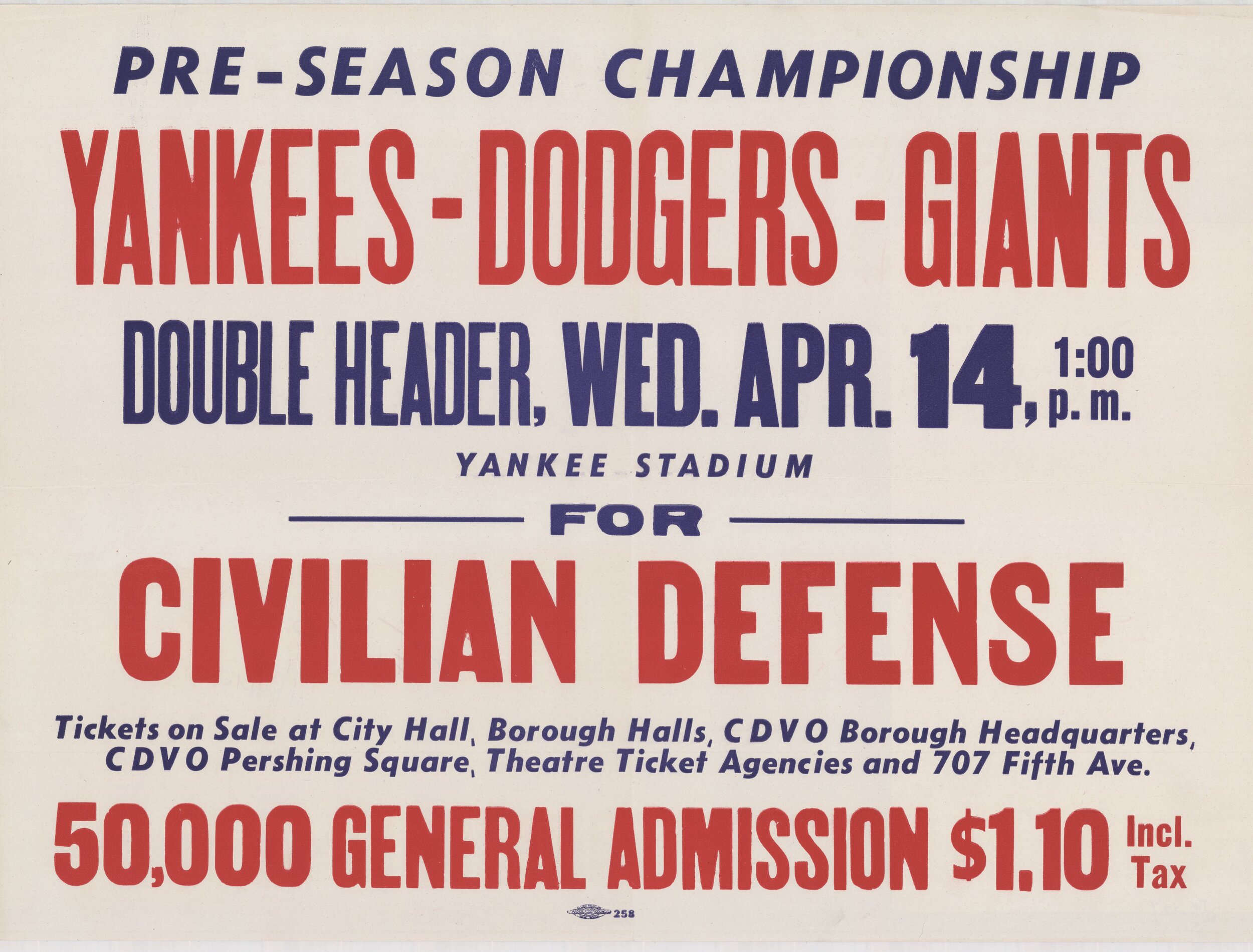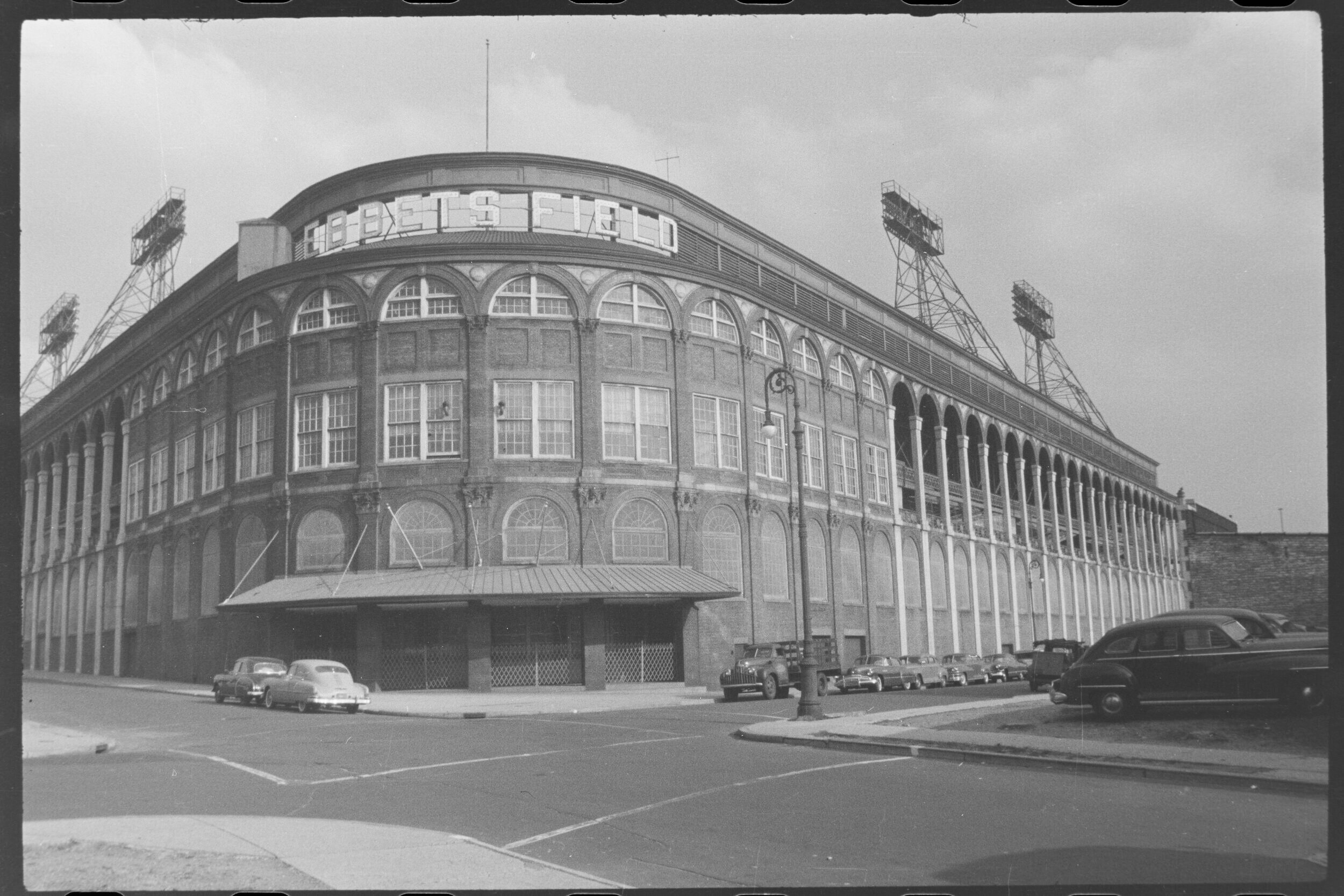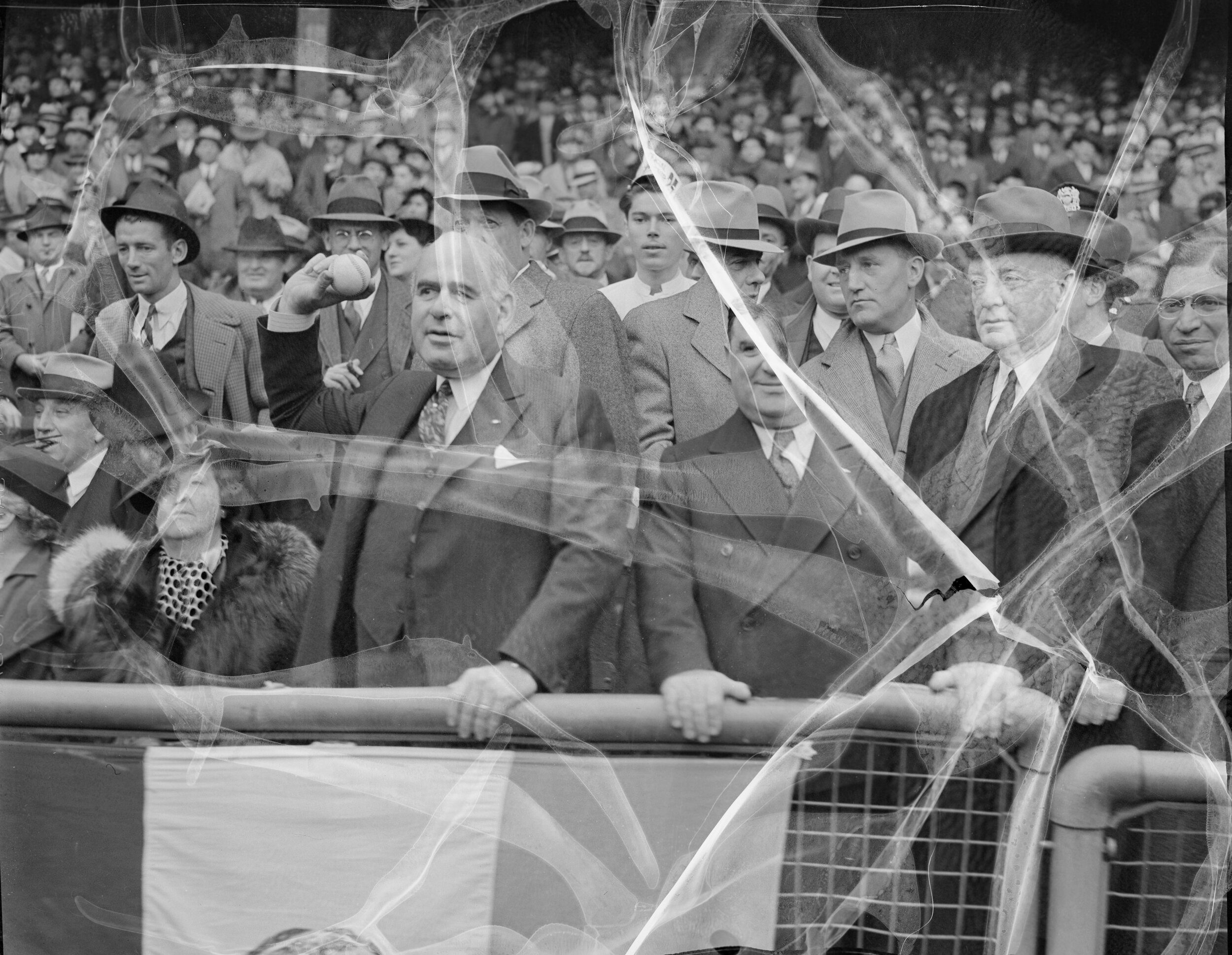It’s 1958 all over again.
That was the year after the Brooklyn Dodgers and New York Giants played their last games in New York City and left for the West Coast – Los Angeles and San Francisco respectively. Those storied old National League ballparks – Ebbets Field and the Polo Grounds – became ghost towns, with no teams playing in them and no fans cheering, booing, drinking beer and munching on hot dogs.
More than 35,000 baseball fans turned out to witness the Dodgers defeat both the Yankees (6-1) and the Giants (1-0) in a double header at Yankee Stadium to benefit the Civilian Defense Volunteer Office on April 14, 1943. Fiorello LaGuardia Collection. NYC Municipal Archives.
Now, 62 years later, all the ball parks across North America, from Boston to San Diego, are ghost towns – victims of the coronavirus, COVID-19, that has scratched at least the first half of the baseball season. There were tentative plans to start the season in July, but many details – big and small – must still be worked out.
But a trip through the Municipal Archives digital galleries brings back those sweet memories of the 1955 Brooklyn Dodgers – “The Boys of Summer” Roger Kahn wrote about, and the rival New York Giants. The Yankees were the only game in town from 1957 through 1961, depriving at least two-thirds of all New York baseball fans of a team to root for.
Now, even Yankee Stadium is quiet in this Summer of Covid-19.
Mr. and Mrs. Babe Ruth (center) and Kate Smith (lower left) at the 1936 World Series (Yankees vs. Giants) at the Polo Grounds. WPA Federal Writers’ Project Collection. NYC Municipal Archives.
The Dodgers and Giants rivalry dates back to the 1880s. They first faced each other in the 1889 World Series, when the Giants, based in Manhattan, played against a Dodgers’ forerunner, the Bridegrooms from Brooklyn. It was an inter-city rivalry — Brooklyn and New York City were separate cities at the time. The Giants, who played in the Polo Grounds, took the best-of-11 series, six games to three from Brooklyn, which played in the old Washington Park near the Gowanus Canal.
Charles Ebbets eventually accumulated 80 percent ownership of the Dodgers and built Ebbets Field at a cost of $775,000 ($19.4 million in today’s dollars) in 1912. The new stadium hosted its first game in April 1913.
Ebbets Field, plot plan, New building application,1912, Department of Buildings (Brooklyn) Collection. NYC Municipal Archives.
Ebbets Field, Cedar Place elevation. New building application,1912, Department of Buildings (Brooklyn) Collection. NYC Municipal Archives.
Ebbets Field, Second tier plan, New building application,1912, Department of Buildings (Brooklyn) Collection. NYC Municipal Archives.
The team, known lovingly as “Dem Bums,” had its share of characters in the 1930s, including Dazzy Vance, Babe Herman and Chick Fewster, who somehow once all ended up up on third base at the same time. Two were called out in one of baseball’s wackiest plays.
They also had some of the most loyal fans who stuck with them despite losing five of six World Series matchups with the Yankees between 1941 and 1956 – and their collapse in 1951 when they blew a 14-game lead to the Giants and lost the pennant race on Bobby Thompson’s homer known as the “Shot Heard ‘Round the World.”
Ebbets Field, Brooklyn. 1940 Tax Photograph Collection. NYC Municipal Archives.
In the late 1940s, when Brooklyn had a growing African-American population, General Manager Branch Rickey broke the game’s color barrier by signing Jackie Robinson, who overcame discrimination, segregation and vicious taunting by opposing players and fans in other cities, to become the first black Major League Baseball player and Rookie of the Year in in 1947. He later led the Dodgers to their only World Series championship in 1955. (No one counts the 1889 win as a Dodger victory since they were then called the Bridegrooms, ostensibly because about a half dozen of their players got married in 1888).
Polo Grounds, Field and Lower Grandstand plan. NYC Municipal Archives.
Then the seemingly impossible happened – owner Walter O’Malley decided to move the beloved Bums to Los Angeles after a rancorous fight with the city and its imperious Parks Commissioner, Robert Moses, over building the Dodgers a new ballpark to replace the deteriorating Ebbets Field.
The Municipal Archives contains letters, telegrams, and pleas, mostly from Brooklynites, to build the Dodgers a new stadium at Atlantic and Flatbush Avenues – all for naught. The Dodgers played their last game at Ebbets Field on September 24, 1957, beating the Pittsburgh Pirates 2-0 in front of a paltry crowd of just 6,700 fans. The stadium’s capacity was about 30,000 at the time every game was nearly sold out during the Dodgers’ heyday.
At the same time, the Giants, who played in the Polo Grounds since 1885, were also planning to go westward. The team, known as the Gothams from 1883 to 1885, fielded some powerhouse teams winning a handful of pennants and World Series matchups in the early 1900s and then again in the 1930s through 1954.
Baseball teams composed of active members of the New York City Police, Fire, and Sanitation Departments drew crowds to the Polo Grounds stadium in the late 1930s. The New York Police Department vs. the Sanitation Department, September 17, 1939. New York Police Department Collection. NYC Municipal Archives.
During those years, fans filled the stands to root for such as stars as Mel Ott, Carl Hubbell, Bill Terry, Bobby Thomson, Sal Maglie and Willie Mays, who made a nearly impossible over-the-shoulder catch of a Vic Wertz blast to deepest center field of the Polo Grounds – some 470 feet from home plate – during the 1954 World Series between the Giants and the Cleveland Indians.
The Polo Grounds also hosted games between city police, fire, and sanitation teams for many years when the Giants were out of town – as well as Negro League games. In 1941, the Dodgers, Giants and Yankees played a double header “City Championship” game at Yankee Stadium, offering 50,000 tickets at $1.10 apiece.
The New York Police Department vs. the Fire Department, Polo Grounds, June 11, 1938. New York Police Department Collection. NYC Municipal Archives.
But in 1957, Giants owner Horace Stoneham joined forces with O’Malley and went to California seeking a second Gold Rush. The Giants played their last game at the Polo Grounds on Sept. 29, 1957, losing to Pittsburgh 9-1.
Collegiate football at the Polo Grounds. Texas A. & M. vs. Manhattan College, October 1937. WPA Federal Writers’ Project Collection. NYC Municipal Archives.
Like Ebbets Field, the Polo Grounds went quiet for baseball. For Ebbets Field and the Dodgers,the quiet was permanent. The stadium was demolished in 1960 and replaced by a huge housing complex known as the Ebbets Field Apartments; the only remnant of the baseball stadium is a plaque.
The Polo Grounds, which had hosted many football games over the years, went quiet for baseball until the New York Mets were founded in 1963: They played their first two hapless seasons there while Shea Stadium was being built. The Polo Grounds, home of the old American Football League’s New York Titans in the early 1960s, hosted its last-ever game in September 1963. It was torn down the following year to be replaced by a giant – pardon the pun – housing complex. All that remains is a huge old staircase that led from Coogan’s Bluff downhill to the stadium.
Mayor LaGuardia stands by while New York State Governor Herbert Lehman prepares to throw out the first ball for the first game of the 1936 World Series (Yankees vs. Giants) at the Polo Grounds, September 30, 1936. (Negative damaged.) WPA Federal Writers’ Project Collection. NYC Municipal Archives.
And, now in the Spring and Summer of 2020 the ballparks of New York – Citi Field and a new Yankee Stadium – are once again quiet. The Boys of Summer are gone once again.
Spectators enjoy the 1936 World Series ( Yankees vs. Giants) at the Polo Grounds, 1936. WPA Federal Writer’s Project Collection. NYC Municipal Archives.
There are no fans roaring like they did when Willie Mays robbed Vic Wertz at the Polo Grounds; no wild cheers as when Gil Hodges — tied the then-record for most National League grand slams in early September 1957 at Ebbets Field. Things just won’t be the same until a Major League umpire cries out “Play Ball,” in a stadium that, for at least a while, won’t have any fans in attendance, no kids to chase after balls in the stands and no smell of hot dogs and beer.
Every baseball fan in America is waiting.











